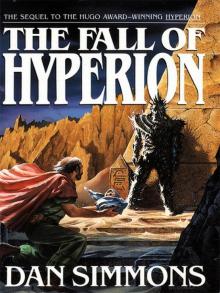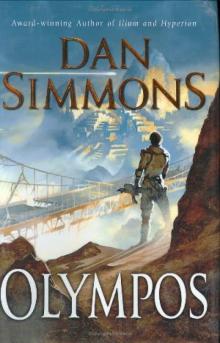- Home
- Dan Simmons
Worlds Enough & Time Page 19
Worlds Enough & Time Read online
Page 19
Secretary Bright Moon did not blink. “The bu…the mantispids seem to get around their freehold in Antarctica quite well,” she said flatly. “And sometimes they walk on two legs.”
Paul snorted. Gary kept his hands clasped behind his head, his shoulders back, posture relaxed, but his eyes were flint. “I presume that if this bug climbed with us, that you’d hold us responsible for his safety and well-being,” he said.
The Secretary’s head turned as smoothly as an owl’s. “You presume correctly,” she said. “That would be our first concern. The safety of the Listeners is always our first concern.”
Gary lowered his hands and shook his head. “Impossible. Above eight thousand meters, no one can help anyone.”
“That’s why they call that altitude the Death Zone,” said Paul. He sounded angry.
Bright Moon ignored Paul and kept her gaze locked with Gary’s. She had spent too many decades steeped in power, negotiation, and political in-fighting not to know who our leader was. “We can make the climb safer,” she said. “Phones, CMG’s on immediate call, uplinks…”
Gary was shaking his head again. “We do this climb without phones and medevac capability from the mountain.”
“That’s absurd…” began the Secretary of State.
Gary cut her off. “That’s the way it is,” he said. “That’s what real mountaineers do in this day and age. And what we don’t do is come to this fucking obscenity of a restaurant.” He gestured toward the darkened Hillary Room to our right, the gesture including all of the revolving Top of the World. One of the Marines blinked at Gary’s obscenity.
Secretary Bright Moon did not blink. “All right, Mr. Sheridan. The phones and CMG medevacs are not negotiable. I presume everything else is.”
Gary said nothing for a minute. Finally, “I presume that if we say no, that you’re going to make our lives a living hell.”
The Secretary of State smiled ever so slightly. “I think that all of you will find that there will be no more visas for foreign climbs,” she said. “Ever. And all of you may encounter difficulties with your taxes soon. Especially you, Mr. Sheridan, since your corporate accounts are so…complicated.”
Gary returned her smile. For an instant it seemed as if he were actually enjoying this. “And if we say yes,” he said slowly, almost drawling, “what’s in it for us?”
Bright Moon nodded and one of the lackeys to her left opened another dossier and slid a slick color photograph across the table toward us. Again all three of us leaned forward to look. Paul frowned. It took me a minute to figure out what it was—some sort of reddish shield volcano. Hawaii?
“Mars,” Gary said softly. “Olympus Mons.”
Secretary Bright Moon said, “It is more than twice as tall as Mt. Everest.”
Gary laughed easily. “Twice as tall? Shit, woman, Olympus Mons is more than three times the height of Everest—more than eighty-eight thousand feet high, three hundred and thirty-five miles in diameter. The caldera is fifty-three miles wide. Christ, the outward facing cliff ringing the bottom of the thing is taller than Everest—thirty-two thousand eight hundred feet, vertical with an overhang.”
Bright Moon had finally blinked at the “Shit, woman”—I wondered wildly when the last time had been that someone had spoken to this Secretary of State like that—but now she smiled.
Gary said, “So what? The Mars program is dead. We chickened out, just like with the Apollo Program seventy-five years ago. Don’t tell me that you’re offering to send us there, because we don’t even have the technology to go back.”
“The bugs do,” said Secretary Bright Moon. “And if you agree to let the son of the mantispid speaker climb K2 with you, the Listeners guarantee that they will transport you to Mars within twelve months—evidently the transit time will be only two weeks each direction—and they’ll outfit a mountain climbing expedition up Olympus Mons for you. Pressure suits, rebreathers, the whole nine yards.”
The three of us exchanged glances. We did not have to discuss this. We looked back at the photograph. Finally Gary looked up at Bright Moon. “What do we have to do other than climb with him?”
“Keep him alive if you can,” she said.
Gary shook his head. “You heard Paul. Above eight thousand meters, we can’t guarantee even keeping ourselves alive.”
The Secretary nodded, but said softly, “Still, if we added a simple emergency calling device to one of your palmlogs—a distress beacon, as it were—this would allow us to come quickly to evacuate the mantispid if there were a problem or illness or injury to him, without interfering with the…integrity…of the rest of your climb.”
“A red panic button,” said Gary but the three of us exchanged glances. This idea was distasteful but reasonable in its way. Besides, once the bug was taken off the hill, for whatever reason, the three of us could get on with the climb and maybe still get a crack at Olympus Mons. “What else?” Gary asked the woman.
Secretary Bright Moon folded her hands and lowered her gaze a moment. When she looked up again, her gaze appeared to be candid. “You gentlemen know how little the mantispids have talked to us…how little technology they have shared with us…”
“They gave us CMG,” interrupted Gary.
“Yes,” said Bright Moon, “CMG in exchange for their Antarctic freehold. But we’ve only had hints of the other wonders they could share with us—generation starflight technology, a cure for cancer, free energy. The Listeners just…well, listen. This is the first overture they’ve made.”
The three of us waited.
“We want you to record everything this son of the Speaker says during the climb,” said Secretary Bright Moon. “Ask questions. Listen to the answers. Make friends with him if you can. That’s all.”
Gary shook his head. “We don’t want to wear a wire.” Before Bright Moon could object, he went on, “We have to wear thermskins—molecular heat membranes. We’re not going to wear wires under or over them.”
The Secretary looked as if she was ready to order the Marines to shoot Gary and probably throw Paul and me out the window, not that the window could be opened. The whole damned restaurant was pressurized.
“I’ll do it,” I said.
Gary and Paul looked at me in surprise. I admit that I was also surprised at the offer. I shrugged. “Why not? My folks died of cancer. I wouldn’t mind finding a cure. You guys can weave a recording wire into my overparka. Or I can use the recorder in my palmlog. I’ll record the bug when I can, but I’ll summarize the other conversations on my palmlog. You know, keep a record of things.”
Secretary Betty Willard Bright Moon looked as if she was swallowing gall, but she nodded, first to us and then at the Marine guards. The Marines came around the table to escort us back to the UN CMG.
“Wait,” said Gary before we were led away. “Does this bug have a name?”
“Kanakaredes,” said the Secretary of State, not even looking up at us.
“Sounds Greek,” said Paul.
“I seriously doubt it,” said Secretary Bright Moon.
K2 Base Camp, 16,500 feet
I guess I expected a little flying saucer—a smaller version of the shuttle craft the bugs had first landed near the UN nine years earlier—but they all arrived in an oversized, bright red Daimler Chrysler CMG. I saw them first and shouted. Gary and Paul came out of the supply tent where they had been triple-checking our provisions.
Secretary Bright Moon wasn’t there to see us off, of course—we hadn’t spoken to her since the night at the Top of the World three days earlier—but the Listener Liaison guy, William Grimes, and two of his aides got out of the CMG, as did two bugs, one slightly larger than the other. The smaller mantispid had some sort of clear, bubbly backpack along his dorsal ridge, nestled in the “V” where its main body section joined the prothorax.
The three of us crossed the boulder field until we were facing the five of them. It was the first time I had ever seen the aliens in person—I mean, who ever sees a bug
in person?—and I admit that I was nervous. Behind us, above us, spindrift and cloud whirled from the ridges and summit of K2. If the mantispids smelled weird, I couldn’t pick it up since the breeze was blowing from behind the three of us.
“Mr. Sheridan, Mr. Hiraga, Mr. Pettigrew,” said the bureaucrat Grimes, “may I introduce Listener Speaker Aduradake and his…son… Kanakaredes.”
The taller of the two bugs unfolded that weird arm or foreleg, swiveled the short forearm thing up like a praying mantis unlimbering, and offered Gary its three-fingered hand. Gary shook it. Paul shook it. I shook it. It felt boneless.
The shorter bug watched, its two primary eyes black and unreadable, its smaller side-eyes lidded and sleepy-looking. It—Kanakaredes—did not offer to shake hands.
“My people thank you for agreeing to allow Kanakaredes to accompany you on this expedition,” said Speaker Aduradake. I don’t know if they used implanted voice synthesizers to speak to us—I think not—but the English came out as a carefully modulated series of clicks and sighs. Quite understandable, but strange, very strange.
“No problem,” said Gary.
It looked as if the UN bureaucrats wanted to say more—make some speeches, perhaps—but Speaker Aduradake swiveled on his four rear legs and picked his way across the boulders to the CMG’s ramp. The humans scurried to catch up. Half a minute later and the vehicle was nothing more than a red speck in the blue southern sky.
The four of us stood there silent for a second, listening to the wind howl around the remaining seracs of the Godwin-Austen Glacier and through niches in the wind-carved boulders. Finally Gary said, “You bring all the shit we e-mailed you about?”
“Yes,” said Kanakaredes. His forearms swiveled in their high sockets, the long mantis femur moved up and back, and the third segment swiveled downward so that the soft, three-fingered hands could pat the clear pack on his back. “Brought all the shit, just as you e-mailed.” His clicks and sighs sounded just like the other bug’s.
“Compatible North Face smart tent?” said Gary.
The bug nodded—or at least I took that movement of the broad, beaked head as a nod. Gary must also have. “Rations for two weeks?” he asked.
“Yes,” said Kanakaredes.
“We have the climbing gear for you,” said Gary. “Grimes said that you’ve practiced with it all—crampons, ropes, knots, weblines, ice axe, jumars—that you’ve been on a mountain before.”
“Mt. Erebus,” said Kanakaredes. “I have practiced there for some months.”
Gary sighed. “K2 is a little different from Mt. Erebus.”
We were all silent again for a bit. The wind howled and blew my long hair forward around my face. Finally Paul pointed up the glacier where it curved near Base Camp and rose toward the east side of K2 and beneath the back side of Broad Peak. I could just see the icefall where the glacier met the Abruzzi Ridge on K2. That ridge, path of the first attempt on the mountain and line of the first successful summit assault, was our fallback route if our attempt on the North-East Ridge and East Face fell behind schedule.
“You see, we could fly over the glacier and start the climb from the base of the Abruzzi at 18,000 feet,” said Paul, “miss all the crevasse danger that way, but it’s part of the climb to start from here.”
Kanakaredes said nothing. His two primary eyes had clear membranes but the eyes never blinked. They stared blackly at Paul. The other two eyes were looking God knows where.
I felt that I should say something. Anything. I cleared my throat.
“Fuck it,” said Gary. “We’re burning daylight. Let’s load ’em up and move ’em out.”
Camp One, North-East Ridge, about 18,300 feet
They call K2 “the savage mountain” and a hundred other names—all respectful. It’s a killer mountain; more men and women have died on it in terms of percentage of those attempting to climb it than on any other peak in the Himalayas or the Karakoram. It is not malevolent. It is simply the Zen-essence of mountain—hard, tall, pyramidal when seen from the south in the perfect child’s-drawing iconic model of the Matterhorn, jagged, steep, knife-ridged, wracked by frequent avalanche and unearthly storms, its essentially airless summit almost continuously blasted by the Jet Stream. No contortion of sentiment or personification can suggest that this mountain gives the slightest shit about human hopes or human life. In a way that is impossible to articulate and politically incorrect even to suggest, K2 is profoundly masculine. It is eternally indifferent and absolutely unforgiving. Climbers have loved it and triumphed on it and died on it for more than a century.
Now it was our turn to see which way this particular prayer wheel turned.
Have you ever watched a mantispid bug walk? I mean, we’ve all seen them on HDTV or VirP—there’s an entire satellite channel dedicated to them, for Christ’s sake—but usually that’s just quick cuts, long-lens images, or static shots of the bug Speaker and some political bigshots standing around somewhere. Have you ever watched them walk for any length of time?
In crossing the upper reaches of the Godwin-Austen Glacier under the eleven-thousand-foot vertical wall that is the East Face of K2, you have two choices. You can stay near the edges of the glacier, where there are almost no crevasses, and risk serious avalanche danger, or you can stick to the center of the glacier and never know when the snow and ice underfoot are suddenly going to collapse into a hidden crevasse. Any climber worth his or her salt will choose the crevasse-route if there’s even a hint of avalanche risk. Skill and experience can help you avoid crevasses; there’s not a goddamn thing in the world you can do except pray when an avalanche comes your way.
To climb the glacier, we had to rope up. Gary, Paul, and I had discussed this—whether or not to rope with the bug—but when we reached the part of the glacier where crevasses would be most probable, inevitable actually, we really didn’t have a choice. It would have been murder to let Kanakaredes proceed unroped.
One of the first things all of us thought when the bugs landed almost ten years ago was “Are they wearing clothes?” We know now that they weren’t—that their weird combination of chitinous exoskeleton on their main body section and layers of different membranes on the softer parts serve well in lieu of clothing—but that doesn’t mean that they go around with their sexual parts showing. Theoretically, mantispids are sexual creatures—male or female—but I’ve never heard of a human being who’s seen a bug’s genitals, and I can testify that Gary, Paul, and I didn’t want to be the first.
Still, the aliens rig themselves with toolbelts or harnesses or whatever when necessary—just as Kanakaredes had shown up with that weird bubblepack on his back with all of his climbing gear in it—and as soon as we started the ascent, he removed a harness from that pack and rigged it around that chunky, almost armored upper section of himself where his arm and midleg sockets were. He also used a regulation-sized metal ice axe, gripping the curved metal top in those three boneless fingers. It seemed strange to see something as prosaic as a red nylon climbing harness and carabiners and an ice axe on a bug, but that’s what he had.
When it came time to rope up, we clipped the spidersilk line onto our ‘biners, passing the line back in our usual climbing order, except that this time—instead of Paul’s ass slowly slogging up the glacier in front of me—I got to watch Kanakaredes plod along ten paces ahead of me for hour after hour.
“Plod along” really doesn’t do bug locomotion justice. We’ve all seen the bugs balance and walk on their midlegs, standing more upright on those balancing legs, their back straightening, their head coming up until they’re tall enough to stare a short human male in the eye, their forelegs suddenly looking more like real arms than praying mantis appendages—but I suspect now that they do that just for that reason—to appear more human in their rare public appearances. So far, Kanakaredes had stood on just two legs only during the formal meeting back at Base Camp. As soon as we started hiking up the glacier, his head came down and forward, that “V” between his main body
section and prothorax widened, those mantis-arms stretched straight ahead like a human extending two poles ahead of him, and he fell into a seemingly effortless four-legged motion.
But, Jesus Christ, what a weird motion. All of a bug’s legs have three joints, of course, but I realized after only a few minutes of following this particular bug up the Godwin-Austen Glacier that those joints never seem to bend the same way at the same time. One of those praying mantis forelegs would be bent double and down so that Kanakaredes could plant his ice axe in the slope, while the other bent forward and then back so that he could scratch that weird beak of a snout. At the same time, the midlegs would be bending rather like a horse’s, only instead of a hoof, the lower, shortest section ended in those chitinous but somehow dainty, divided…hell, I don’t know, hoof-feet. And the hind legs, the ones socketed at the base of the soft prothorax…those are the ones that made me dizzy as I watched the bug climbing through soft snow in front of me. Sometimes the alien’s knees—those first joints about two-thirds of the way down the legs—would be higher than his back. At other times one knee would be bending forward, the other one back, while the lower joints were doing even stranger things.
After a while, I gave up trying to figure out the engineering of the creature, and just began admiring the easy way it moved up the steep snow and ice. The three of us had worried about the small surface area of a bug’s feet on snow—the V-shaped hoof-things aren’t even as large as an unshod human foot—and wondered if we’d be tugging the mantispid out of every drift on our way up the mountain, but Kanakaredes managed quite well, thank you. I guess it was due to the fact that I guessed at that time that he probably only weighed about a hundred and fifty pounds, and that weight was spread out over four—and sometimes six, when he tucked the ice axe in his harness and scrambled—walking surfaces. To tell the truth, the bug had to help me slog clear of deep snow two or three times on the upper reaches of the glacier.

 The Terror
The Terror Endymion
Endymion Hyperion
Hyperion The Crook Factory
The Crook Factory Ilium
Ilium Phases of Gravity
Phases of Gravity Hardcase
Hardcase Fires of Eden
Fires of Eden Children of the Night
Children of the Night Muse of Fire
Muse of Fire Drood
Drood The Fifth Heart
The Fifth Heart Carrion Comfort
Carrion Comfort The Hollow Man
The Hollow Man Summer of Night
Summer of Night The Fall of Hyperion
The Fall of Hyperion Black Hills
Black Hills A Winter Haunting
A Winter Haunting Hard Freeze
Hard Freeze Prayers to Broken Stones
Prayers to Broken Stones Hard as Nails
Hard as Nails The Guiding Nose of Ulfant Banderoz
The Guiding Nose of Ulfant Banderoz The Rise of Endymion
The Rise of Endymion Orphans of the Helix
Orphans of the Helix Lovedeath
Lovedeath Olympos
Olympos Darwin's Blade
Darwin's Blade Song of Kali
Song of Kali Worlds Enough & Time: Five Tales of Speculative Fiction
Worlds Enough & Time: Five Tales of Speculative Fiction The Abominable
The Abominable The Death of the Centaur
The Death of the Centaur Hard as Nails jk-3
Hard as Nails jk-3 Worlds Enough & Time
Worlds Enough & Time Joe Kurtz Omnibus
Joe Kurtz Omnibus The Hyperion Cantos 4-Book Bundle
The Hyperion Cantos 4-Book Bundle Rise of Endymion
Rise of Endymion Hard Freeze jk-2
Hard Freeze jk-2 Olympos t-2
Olympos t-2 The Abominable: A Novel
The Abominable: A Novel Hyperion h-1
Hyperion h-1 Remembering Siri
Remembering Siri Black Hills: A Novel
Black Hills: A Novel Ilium t-1
Ilium t-1 Hardcase jk-1
Hardcase jk-1 Hyperion 01 - Hyperion
Hyperion 01 - Hyperion